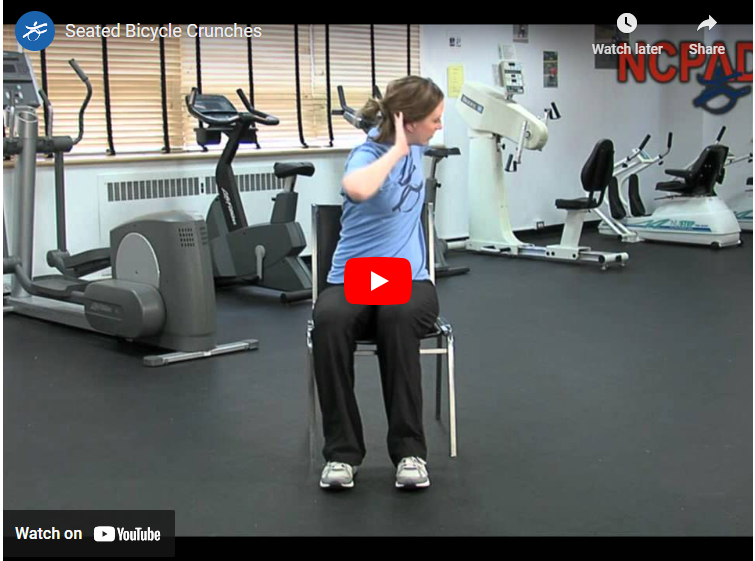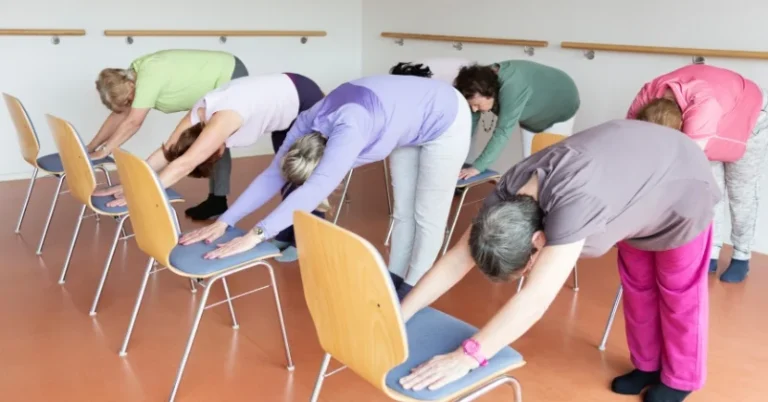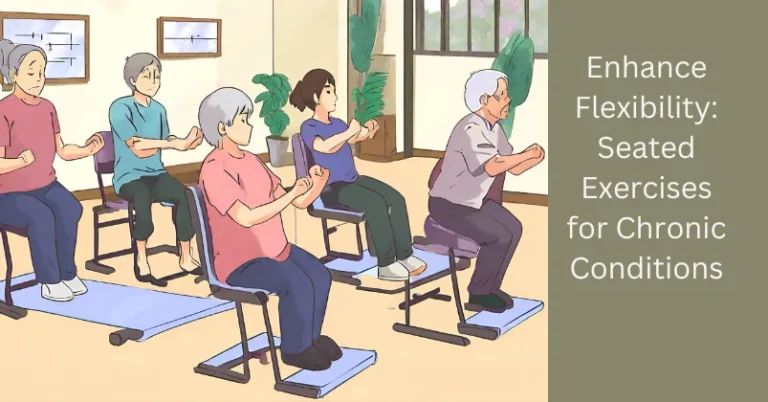Stay Active: Seated Cardio Exercises for Chronic Conditions
Staying active is important for maintaining good health, especially for those with chronic conditions. However, some people may find it difficult to engage in traditional forms of exercise due to physical limitations. Seated cardio exercises can be a great alternative for individuals with chronic conditions who need to remain seated while exercising.
Seated cardio exercises are designed to increase heart rate and improve cardiovascular health while the individual remains seated. These exercises can be done at home or in a gym setting and are suitable for people of all ages and fitness levels. Seated cardio exercises can be particularly beneficial for those with chronic conditions such as arthritis, heart disease, and diabetes, as they provide a low-impact workout that is easy on the joints.
By incorporating seated cardio exercises into your daily routine, you can improve your overall health and well-being. These exercises can help reduce the risk of chronic conditions, improve cardiovascular health, and increase energy levels. Additionally, seated cardio exercises can be a fun and engaging way to stay active, and can be done alone or as part of a group fitness class.
Understanding Chronic Conditions and Physical Activity

Chronic conditions are health conditions that persist over time and can have a significant impact on a person's overall health and quality of life. Some common chronic conditions include arthritis, diabetes, heart disease, and chronic obstructive pulmonary disease (COPD).
Physical activity is an important component of managing chronic conditions. It can help improve overall health, reduce the risk of complications, and enhance quality of life. However, people with chronic conditions may face unique challenges when it comes to physical activity, such as pain, fatigue, and mobility issues.
It is important to understand that physical activity does not have to be strenuous to be beneficial. Even small amounts of activity can make a difference. According to the CDC, adults should aim for at least 150 minutes of moderate-intensity aerobic activity per week, such as brisk walking, cycling, or swimming.
When starting a physical activity program, it is important to consult with a healthcare provider to ensure that it is safe and appropriate for your individual needs and abilities. They can also provide guidance on how to modify activities to accommodate any limitations or symptoms.
In addition to aerobic activity, strength training and stretching can also be beneficial for people with chronic conditions. Strength training can help improve muscle strength and endurance, while stretching can improve flexibility and range of motion.
Overall, physical activity can be an important tool for managing chronic conditions and improving overall health and quality of life. By working with a healthcare provider and incorporating a variety of activities into a routine, people with chronic conditions can stay active and engaged in their daily lives.
The Importance of Staying Active
Physical activity is essential for maintaining good health and well-being. It is particularly important for people with chronic conditions, such as heart disease, arthritis, chronic pain, high blood pressure, or diabetes. Regular exercise can help improve symptoms and reduce the risk of developing other chronic conditions.
When done correctly, physical activity can benefit the heart, boost energy, and improve mood. It can also reduce stress levels and help maintain a healthy weight. Even if someone is unable to engage in high-intensity exercise, there are still many benefits to staying active with low-impact exercises such as seated cardio.
According to the American Heart Association, moderate-intensity aerobic activity for at least 150 minutes per week can help improve heart health and reduce the risk of heart disease. This can include activities such as brisk walking, cycling, or swimming. However, even shorter bouts of activity can be beneficial, especially for those with chronic conditions.
In addition to the physical benefits, staying active can also have a positive impact on mental health. Exercise has been shown to improve mood, reduce symptoms of anxiety and depression, and improve overall quality of life.
Overall, staying active is an important part of maintaining good health, especially for those with chronic conditions. Incorporating regular physical activity into daily routines, such as with seated cardio exercises, can provide numerous benefits for both physical and mental well-being.
Seated Cardio Exercises
Seated cardio exercises are an excellent way to stay active and maintain fitness levels, especially for individuals with chronic conditions. These exercises can be done while sitting down, making them ideal for those who have difficulty standing or walking for extended periods.
Cardio exercises help to increase heart rate and improve blood circulation, which is vital for maintaining good health. When done regularly, these exercises can help to strengthen muscles and improve overall fitness levels.
Some examples of seated cardio exercises include:
- Seated marching: Sit with your feet flat on the floor and march in place, lifting one knee at a time.
- Seated jumping jacks: Sit with your feet flat on the floor and jump your legs out to the sides and back together. Start with your arms at your sides and when you jump your legs out to the side bring your hands above your head. Added bonus if you clap at the top.
- Seated leg lifts: Sit with your feet flat on the floor and lift one leg at a time, keeping your knee straight.
- Seated bicycle: Start with your feet flat on the floor and pedal your legs back and forth as if riding a bicycle.
It's essential to maintain proper form and technique while performing these exercises to avoid injury. Start with a few repetitions and gradually increase the number as your fitness level improves.
Incorporating seated cardio exercises into your daily routine can help to improve heart health, increase muscle strength, and boost overall fitness levels. So, get moving and stay active with these simple yet effective exercises.
Benefits of Seated Cardio for Chronic Conditions

Seated cardio exercises are a great way to stay active, especially for individuals with chronic conditions. These exercises can provide numerous benefits, including:
- Improved cardiovascular health: Seated cardio exercises can help improve heart health by increasing blood circulation, reducing the risk of heart disease, stroke, and other cardiovascular conditions.
- Better blood sugar control: For individuals with type 2 diabetes, seated cardio exercises can help lower blood sugar levels and reduce the risk of complications.
- Reduced joint pain: Seated cardio exercises are low-impact, making them a great option for individuals with arthritis or other joint conditions. They can help reduce joint pain and stiffness while still providing a good workout.
- Increased bone density: Seated cardio exercises can help improve bone density, reducing the risk of osteoporosis and fractures.
- Improved mental health: Regular exercise can help reduce symptoms of depression, anxiety, and dementia, improving overall mental health and cognitive function.
- Reduced cancer risk: Studies have shown that regular exercise can help reduce the risk of certain types of cancer, including breast, colon, and lung cancer.
Overall, seated cardio exercises provide numerous benefits for individuals with chronic conditions. They are a safe and effective way to stay active and improve overall health and well-being.
Specific Exercises and Their Benefits

When it comes to staying active with chronic conditions, there are several types of seated cardio exercises that can help. Here are some specific exercises and their benefits:
Walking and Marching
Walking and marching in place are great seated cardio exercises that can help improve cardiovascular health and increase muscle strength. Brisk walking and marching can also help increase heart rate and promote weight loss.
Cycling and Biking
Cycling and biking exercises can help improve cardiovascular health, increase muscle strength, and improve flexibility. These exercises can also help improve posture and balance.
Stretching and Flexibility Exercises
Stretching and flexibility exercises can help improve flexibility, reduce muscle tension, and improve range of motion. These exercises can also help improve posture and balance.
Strength Training Exercises
Strength training exercises can help increase muscle strength, improve bone density, and improve posture. These exercises can also help promote weight loss and improve overall physical function.
Balance Exercises
Balance exercises can help improve balance and reduce the risk of falls. These exercises can also help improve posture and increase muscle strength.
When performing seated cardio exercises, it's important to focus on major muscle groups and muscle groups that are specifically targeted by the exercise. It's also important to maintain proper form and posture to avoid injury.
Safety Tips and Precautions
When performing seated cardio exercises for chronic conditions, it is important to keep in mind some safety tips and precautions to avoid injuries or discomfort. Here are some tips to follow:
- Consult with your doctor or health care provider before starting any exercise program, especially if you have a chronic condition or are taking medication that may affect your heart rate or blood pressure.
- Start slowly and gradually increase the intensity and duration of your exercises as you feel comfortable. Listen to your body and stop if you experience any pain or discomfort.
- Use proper form and technique when performing the exercises to avoid straining your neck, shoulders, or back. Keep your spine straight, shoulders relaxed, and feet flat on the floor.
- Wear comfortable and supportive shoes to prevent slips or falls. Avoid exercising on slippery or uneven surfaces.
- Stay hydrated by drinking water before, during, and after your workout. Avoid sugary or caffeinated beverages that may dehydrate you.
- Monitor your heart rate and breathing during the exercise. Aim for a moderate intensity level that makes you breathe harder but still allows you to talk comfortably.
- If you experience any chest pain, shortness of breath, dizziness, or other unusual symptoms, stop exercising immediately and seek medical attention.
By following these safety tips and precautions, you can minimize the risk of injury or pain and enjoy the benefits of seated cardio exercises for your chronic condition. It is also recommended to work with a physical therapist or certified trainer who can guide you through the exercises and modify them to meet your needs and abilities.
Incorporating Exercise into Daily Life
Regular exercise is important for everyone, especially those with chronic conditions. Incorporating exercise into your daily life can be challenging, but it's essential for maintaining your health and well-being. Here are some tips to help you get started:
Start Small
If you're new to exercise or haven't been active in a while, start small. Begin with a few minutes of seated cardio exercises each day, and gradually increase your time and intensity. You can use a timer or an app to help you keep track of your progress.
Schedule Your Exercise
Make exercise a priority by scheduling it into your daily routine. Set aside a specific time each day for your seated cardio exercises, and stick to your schedule as much as possible. This will help you establish a routine and make exercise a habit.
Increase Your Activity Level
In addition to your seated cardio exercises, look for ways to increase your activity level throughout the day. Take short walks during your breaks, stand up and stretch during commercials, or do some light housework. Every little bit helps!
Sit Less
Sitting for long periods of time can be detrimental to your health, so look for ways to sit less. Consider using a standing desk or taking frequent breaks to stand up and stretch. You can also try doing some seated exercises while watching TV or reading a book.
Get Support
Exercise is more enjoyable when you have support from family, friends, or a caregiver. Ask someone to join you for your seated cardio exercises, or find a support group for people with similar conditions. Having a support system can help keep you motivated and accountable.
Incorporating exercise into your daily life can be challenging, but it's essential for maintaining your health and well-being. Start small, schedule your exercise, increase your activity level, sit less, and get support. With these tips, you can make exercise a regular part of your routine and enjoy the many benefits of physical activity.
Marching Towards Wellness with Seated Cardio

Seated cardio exercises can be an effective way to stay active for individuals with chronic conditions. These exercises can help improve cardiovascular health, increase muscle strength, and boost energy levels. They can also help manage symptoms associated with conditions such as arthritis, diabetes, and heart disease.
By incorporating seated cardio exercises into your daily routine, you can improve your overall physical health and well-being. It is important to consult with your healthcare provider before starting any new exercise program, especially if you have a chronic condition.
Remember to start slowly and gradually increase the intensity and duration of your workouts. You can also mix up your routine by incorporating different types of seated cardio exercises such as cycling, rowing, and arm circles.
In addition to exercise, it is important to maintain a healthy diet and lifestyle to manage chronic conditions. This includes eating a balanced diet, getting enough sleep, and managing stress levels.
Overall, seated cardio exercises can be a safe and effective way to stay active for individuals with chronic conditions. By incorporating these exercises into your daily routine, you can improve your physical health and quality of life.
FAQs
Seated cardio exercises are a great option for individuals with limited mobility. Some effective seated cardio exercises include seated marching, seated jumping jacks, seated leg lifts, seated cycling, and seated rowing. These exercises can help increase heart rate, improve circulation, and strengthen muscles.
Seated cardio exercises offer many benefits for individuals with chronic conditions. They can help improve cardiovascular health, increase endurance, and reduce the risk of heart disease. Seated cardio exercises can also improve joint mobility, reduce pain, and increase overall physical activity levels.
Seated cardio exercises can help prevent and manage chronic diseases such as diabetes, heart disease, and arthritis. Regular exercise can help control blood sugar levels, reduce blood pressure, and improve cholesterol levels. Seated cardio exercises can also help manage symptoms such as pain, stiffness, and fatigue.
There are many adaptations that can be made to traditional cardio exercises for individuals with disabilities. For example, individuals with limited mobility can perform seated versions of exercises such as jumping jacks, cycling, and rowing. Resistance bands, weights, and other equipment can also be used to adapt cardio exercises for individuals with disabilities.
Individuals with limited mobility can incorporate cardio into their exercise routine by performing seated cardio exercises such as marching, cycling, and rowing. They can also incorporate other forms of low-impact cardio such as swimming, water aerobics, and cycling on a recumbent bike. It is important to start slowly and gradually increase intensity and duration.
Seated cardio exercises are a safe and effective option for the elderly. Some examples of seated cardio exercises include seated marching, seated cycling, seated leg lifts, and seated rowing. These exercises can help improve cardiovascular health, increase endurance, and reduce the risk of falls. It is important to consult with a healthcare provider before starting a new exercise program.









